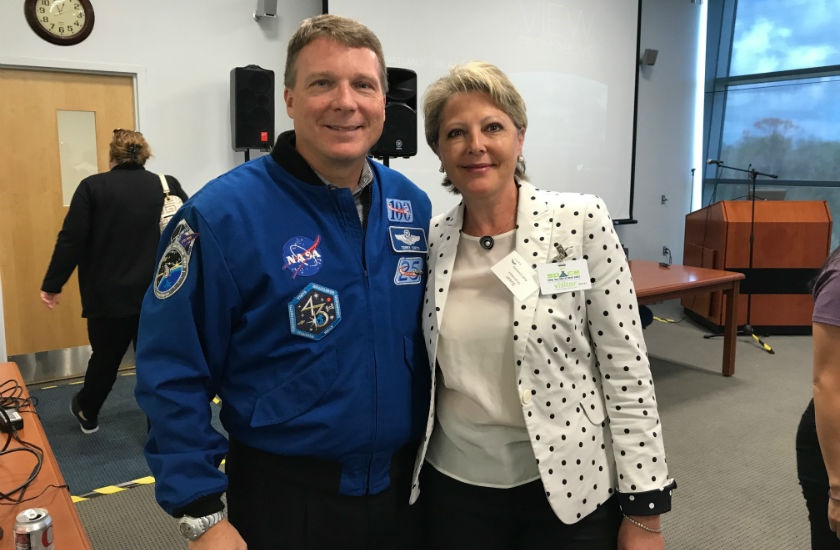Weightlessness takes a paradoxically heavy toll on astronauts who spend extended periods of time in zero gravity. A researcher at Rush is helping lead a National Institutes of Health-sponsored study that’s trying to help make space travel easier on astronauts, and that also may yield insights into the progression, prevention and even possible cure of trauma-induced osteoarthritis for the rest of us here on Earth.
Susan Chubinskaya, PhD, the Klaus Kuettner Professor of Osteoarthritis Research at Rush, will work with the Massachusetts Institute of Technology’s Alan Grodzinsky, ScD, a biomedical engineer, and Vicki Rosen, PhD, a developmental biologist at Harvard School of Dental Medicine, to test the effects of the "microgravity" of space on damaged knee and ankle cartilage. The study is one of the five 2017 Tissue Chips in Space Projects to be conducted aboard the International Space Station (ISS) United States National Laboratory, with funding from the National Center for Advancing Translational Sciences (NCATS), a branch of the NIH.
"We have been collaborating with MIT on multiple projects for more than 20 years. This new project is a natural extension of that partnership" says Chubinskaya, whose own research focuses on how human joint tissue responds to injury. Under her supervision, Rush will provide human joints from organ donors for the project and will assist with culture experiments and analysis of tissue responses to injuries.
Experiments in space yield insights into gravity and activity on bones
Tissue Chips in Space is a collaboration between NCATS and the Center for the Advancement of Science in Space, or CASIS, the nonprofit, nongovernmental organization that manages the ISS. The overall endeavor will investigate human physiology and disease aboard the ISS with an eye to improving the health of astronauts, who lose bone mineral density if they are in microgravity for long, and are prone to joint injuries during their routine exercises while in orbit.
"They experience a lot of changes in their muscular skeletal system, and when they come back, it's not that simple to recover. They need treatment, and we need to understand what happens with the joints while they're up there," Chubinskaya says.
While the other projects will employ tissue-chip technology — tiny models of human organs — the MIT-Rush collaboration on ISS will use dozens of small samples of human knee and ankle components known as osteochondral units, which contain cartilage and bone, along with synovial tissue, a type of connective tissue specific to joints. This model replicates the environment within knee and ankle joints. The samples will be contained in small culture tubes that will each spend a month in space (the scientists in the program will remain on the ground).
Because of Rush's long relationship with Gift of Hope, the federally designated nonprofit agency that coordinates organ and tissue donation in parts of Illinois and Indiana, Rush has access to donated human joints for research.
Trauma-induced arthritis takes long to develop, afflicts patients far longer
Osteoarthritis is the most common chronic condition of the joints and a leading cause of pain and disability among adults 60 and older. The condition, which can be disabling and expensive to treat, occurs when cartilage (connecting tissue) between joints breaks down. The bones then rub together, causing pain and stiffness.
The cartilage can deteriorate for any of a number of reasons, including overuse or obesity. Trauma (damage) to young people's joints in accidents or sports injuries also is a common and pernicious cause of osteoarthritis, and post-traumatic osteoarthritis will be the focus of the ISS experiments.
The problem can take a dozen or more years to develop after an injury, but then can require joint replacement, and even multiple replacements for the same joint over an individual's lifetime. (A replacement joint may only last 10 to 15 years, and post-traumatic osteoarthritis occurs earlier in life than age-related spontaneous osteoarthritis.) Post-traumatic osteoarthritis accounts for about 12 percent of symptomatic osteoarthritis in hips, knees and ankles.
Study will assess how low gravity affects arthritis progression and treatments
The study’s primary focus will be on the mechanisms of post-traumatic osteoarthritis and the effects of certain drugs on the disease course on Earth and in microgravity. "We are trying to model joint injury in order to understand the processes responsible for joint deterioration both on Earth and in space.” Chubinskaya says "We want to find out how to slow down the progression of the disease, or even prevent it."
In Chubinskaya's and Grodzinsky’s labs, healthy donor joint cartilage is deliberately and forcefully injured. Then samples of the damaged cartilage and accompanying synovial tissue are steeped in a "cocktail of cytokines, the inflammatory mediators we know are released as a result of this impaction," Chubinskaya says.
The research team hopes to learn "what controls the degradations" in the tissue after injury, so they can home in on effective treatments. After developing the tissue culture model, the researchers will use it to test five treatment options, including anti-inflammatory small molecule drugs that suppress inflammation and growth factors that stimulate tissue repair and regeneration.
"The same approach then will be taken into space," Chubinskaya says. The researchers will have a chance to see how microgravity affects the progression of osteoarthritis and the effectiveness of the five treatments.
The samples will be aboard the ISS for a month, currently planned to be this December. After they return to Earth, the researchers will analyze them for appearance and multiple biological markers of disease progression, just as they will have done for the samples tested in the Earth labs.
They’ll compare the results with the findings of the Earth experiments. “The data may increase understanding of trauma-induced osteoarthritis in both conditions and for both the general public and astronauts,” Chubinskya says.

